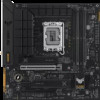Asus TUF GAMING B760M-BTF WIFI D4 Users Manual English - Page 16
Power Button/Soft-off Button header PWR_BTN, Storage Device Activity LED header +HDD_LED
 |
View all Asus TUF GAMING B760M-BTF WIFI D4 manuals
Add to My Manuals
Save this manual to your list of manuals |
Page 16 highlights
15. System Panel header The System Panel header supports several chassis-mounted functions. • System Power LED header (+PWR_LED-) The 2-pin header allows you to connect the System Power LED. The System Power LED lights up when the system is connected to a power source, or when you turn on the system power, and blinks when the system is in sleep mode. PWR_LED+ PWR_LEDPWR GND F_PANEL +PWR_LED- PWR_BTN PIN 1 HDD_LED+ HDD_LED- Ground HWRST# (NC) • Storage Device Activity LED header (+HDD_LED-) The 2-pin header allows you to connect the Storage Device Activity +HDD_LED- RESET LED. The Storage Device Activity LED lights up or blinks when data is read from or written to the storage device or storage device add-on card. • Power Button/Soft-off Button header (PWR_BTN) The 2 pin header allows you to connect the system power button. Press the power button to power up the system, or put the system into sleep or soft-off mode (depending on the operating system settings). • Reset button header (RESET) The 2-pin header allows you to connect the chassis-mounted reset button. Press the reset button to reboot the system. 16. Thunderbolt™ (USB4®) header The Thunderbolt™ (USB4®) header allows you to connect an add-on card that supports Intel®'s Thunderbolt™ Technology or USB4® function. • The add-on card is purchased separately. TB_HEADER • Please visit the official website of your purchased add- PIN 1 on card for more details on compatibility. FORCE_PWR TB_CIO_PLUG_EVENT SLP_S3# SLP_S5# GND RTD3_SW The add-on card can only be used when installed to the PCIEX16(G4) slot. Ensure to install your add-on card to the PCIEX16(G4) slot. 17. Q-LEDs The Q-LEDs check key components (CPU, DRAM, VGA, and booting devices) during the motherboard booting process. If an error is found, the critical component's LED stays lit up until the problem is solved. The Q-LEDs provide the most probable cause of an error code as a starting point for troubleshooting. The actual cause may vary from case to case. I2C_SCL I2C_SDA I2C_IRQ# RTD3_POWER_EN NC PERST_N WAKE# 1-6 Chapter 1: Product Introduction















